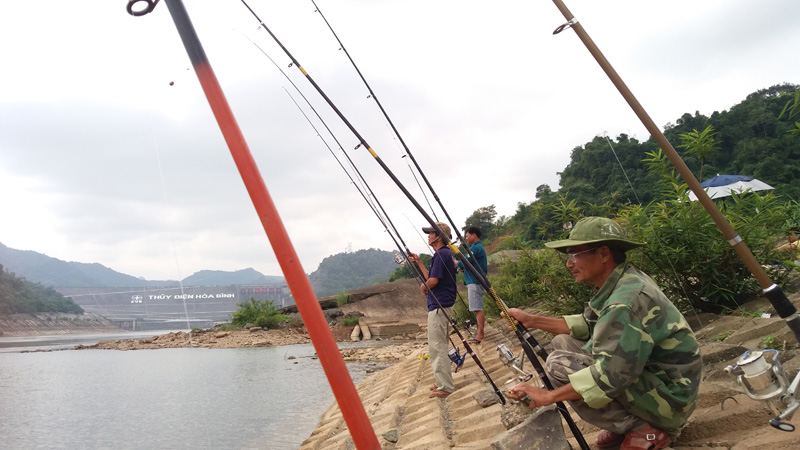
(HBO) – Fishing in the Da River has become a favorite hobby of many locals and tourists to the northwestern mountainous province of Hoa Binh. Fishermen can feel lost in thought and relaxed while fishing, and excited when they can get big and choosy fish.

Fishing
in the Da River is the hobby of many local people
There
are many fishing places along the Da River, from its lower section to the areas
around Dung Spring, the former Da River cement factory and Thia Yen Mong ferry
station, and the section running through Hoa Binh city. Besides, streams running
to the river, along with romantic cliffs, also create a breathtaking landscape.
Hoa
Binh is blessed with the Da River which is dubbed as a rich store of aquatic resources
in the northwestern region. The fish in the clean river are delicious with
various recipes. They can be cooked right on the river banks and on boats,
attracting an increasing number of fishermen - young or old, junior or senior
in the hobby - to the Da River to try their luck. A day without going out fishing
will be enough to make them feel uneasy.
In
the past, fishermen used bamboo rods and rice and sweet potato as bait, but now
things have changed with the use of carbon rods, reels, and mixed bait bought
from the market. It may take them all day to catch a small fish like muong
(hemiculter), chay (spinibarbus caldwelli) and tilapia, but this is enough to
make them feel quite happy. Meanwhile, in a lucky day, they may bring home tens
of kilos of carp or silver carp./.
With an increasingly vibrant and widespread emulation movement aimed at building cultured residential areas and cultured families, Yen Thuy District has been making steady progress toward improving both the material and spiritual well-being of its people, while fostering a civilized, prosperous, beautiful, and progressive community.
Once lacking recreational spaces and community facilities, Residential Group 2 in Quynh Lam Ward (Hoa Binh City) has recently received attention for the construction of a new, spacious, and fully equipped cultural house. The project followed the model of state support combined with public contributions in both labor and funding.
The "All people unite to build cultural life" movement, which has been effectively integrated with Kim Boi district’s socio-economic development goals, is fostering a lively spirit of emulation across local residential areas, hamlets, villages, public agencies, and enterprises. In addition, through the initiative, traditional cultural values are being preserved and promoted, while community solidarity and mutual support in poverty reduction and economic development are being strengthened.
A working delegation of the Hoa Binh provincial People’s Committee led by its Permanent Vice Chairman Nguyen Van Toan on June 11 inspected the progress of a project to build the Mo Muong Cultural Heritage Conservation Space linked to tourism services in Hop Phong commune, Cao Phong district.
Born and growing in the heroic land of Muong Dong, Dinh Thi Kieu Dung, a resident in Bo town of Kim Boi district, in her childhood was nurtured by the sweet lullabies of her grandmother and mother. These melodies deeply imprinted on her soul, becoming an inseparable part of her love for her ethnic group's culture. For over 20 years, this love for her hometown has driven Dung to research, collect, and pass down the cultural values of the Muong people to future generations.
In the final days of May, the Ethnic Art Troupe of Hoa Binh Province organized performances to serve the people in remote, mountainous, and particularly disadvantaged areas within the province. These were not just ordinary artistic shows, but they were the meaningful journeys aimed at spreading cultural values, enhancing the spiritual life of the people and contributing to the preservation of ethnic minority cultural identities.



